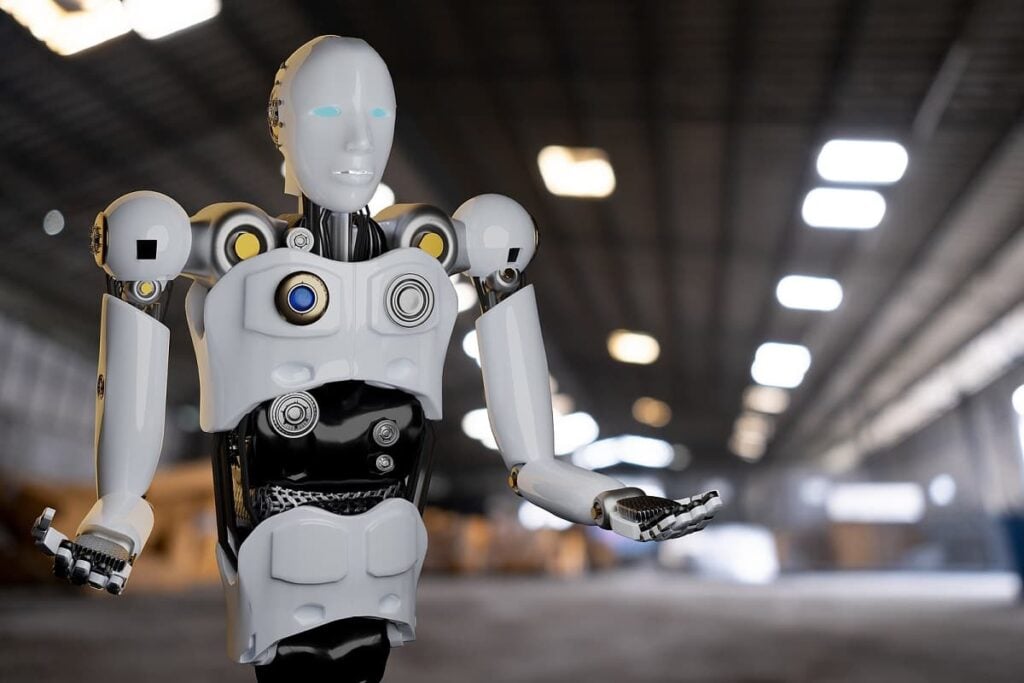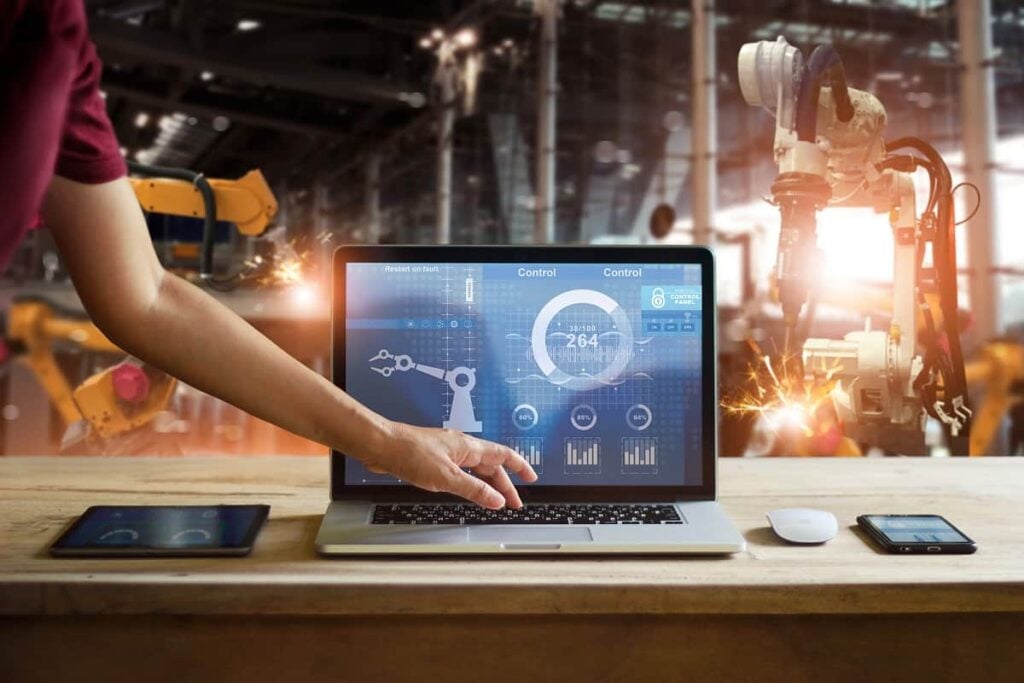5 Robotic Manufacturing Companies for Smart Factories
Table of contents

We’re still a long way from the robot revolution and subsequent technological singularity promised by futurologists, science fiction writers, and overcaffeinated dorm-room philosophers. That said, robotic technology has come a long way since Honda’s (HMC) advanced humanoid robot, ASIMO, embarrassingly fell down the stairs back in 2006. We humans are so confident in our ability to build halfway decent machines that we’re trusting more of our everyday lives to robots with automated cars, kitchens, and even laboratories.

And while Honda shelved ASIMO long ago, the commercial development of non-humanoid robotics is still going strong, as we usher in the Fourth Industrial Revolution. The difference between these new robots and those from the last century is functionality. Roboticists are now developing robots that are task agnostic than older models, especially thanks to artificial intelligence technologies like deep learning. That allows manufacturing companies to re-deploy robots around the factory floor when demand changes or new products come online without losing out on their capital investment.
And despite the fear that robots are here to take over jobs, a 2018 joint study by Deloitte and The Manufacturing Institute has found that jobs have been growing since the introduction of AI and robotic technologies (at least, before The Rona hit). The trouble is that there’s been an ever-widening skills gap that’ll leave an estimated 2.4 million manufacturing positions unfilled between 2018 and 2028 in the United States. But that could also be because the U.S. education system still lags behind most developed countries and needs a serious reboot.
The Future of the Workforce
Deloitte and The Manufacturing Institute reimagined some fancy new job titles that’ll get humans back in the game while still making room for the growing tide of robots in manufacturing. For the most part, the study pretty much came up with names by throwing a dart at a board with some words and slapping “smart” in front of them, like “Smart Factory Manager” and “Smart Scheduler.” These reinvented manufacturing jobs will have some remote work option patched on to them by interfacing workers with the digital tools to manage and collaborate with robots. But let’s be honest, the robots will probably be doing most of the work while workers search online for the coolest gadgets on Amazon (AMZN).

Global Workplace Analytics estimated that 75 million workers, or 56% of the U.S. workforce, could be telecommuting in the near future. As more of the manufacturing sector replaces human workers with AI and robotics technology, those telecommuters are going to start to include workers who were more likely to stand next to the assembly line than stare at a computer all day, especially if those workers have job titles that include the word “smart.” McKinsey reported that employers in the U.S. and Europe are already seeing a mismatch between educational credentials held by candidates compared to what companies need, driven largely by digital work and automation. In all sectors, there will be a growing need for higher cognitive, social and emotional, and technological skills over pre-existing physical, manual, and basic cognitive skills.
The McKinsey study found that manufacturing will be one of the hardest-hit sectors during this future skill shift. Demand for physical and manual skills is already decreasing at twice the rate compared to the rest of the economy.
The Smart Factory
The dream is for factories to operate in a seamless, pristine manner with no waste produced. With intelligent machines running the show, data will be crunched at lightning speed and communicated across hundreds of production lines manned by robotics. No more downtime from arguments between the foreman and assembly workers about who should have won the NFL Super Bowl. Efficiency will be maximized using intelligent analytics to ensure every process is completed on time, from raw material intake to customer delivery, even if the Green Bay Packers win that year.

The benefits of a fully automated smart factory are staggering. Deloitte reported that a leading electronics company designed a smart factory with fully automated production systems, which led to lower lead times, lower costs, increased production capacity, and 50% fewer defective products. Labor productivity is estimated to increase by 30% from 2011, when the Fourth Industrial Revolution unofficially began, to 2030. The estimated market value for smart factories is a whopping $270.8 billion, according to Mordor Intelligence. While we’re not sure how the team at Mordor Intelligence come up with that number, we’re confident they had a few people with “Smart” in their job titles.

But smart factories don’t just materialize out of thin air. Roboticists, computer scientists, engineers, and Asimov fangirls and boys are working around the clock to make automation a reality for us all.
Let’s take a look at five companies that are building the future of robotic manufacturing for smart factories.
Adaptive Robotic Manufacturing for Smart Factories
Founded in 2016, Santa Clara, California-based Flexiv is designing and manufacturing adaptive robots for general industrial purposes. Flexiv has raised $106.5 million after a Series B round back in December 2020 that included Yunfeng Capital, the investment firm of Alibaba’s Jack Ma. The founding team has its roots in the robotics and AI laboratories at the capital of robotics itself, Stanford University. Flexiv’s first product, Rizon, can adapt to changes, like small position errors from vibrations that typically occur during manufacturing and human interference, and promises to automate complex tasks with the hand-eye coordination of a human.

The key behind its technology is a combination of precise-force sensing, which allows the robot arm to respond quickly to tiny changes in force, and AI vision to re-correct for positioning. Flexiv currently offers Rizon for applications such as polishing curved surfaces, plugging wires, and assembling components, with the possibility of other customized needs. And, no, not those kinds of needs.
Founded in 2014, Emeryville, California-based Symbio Robotics develops AI software for the control of industrial robots. The robotics startup just emerged from stealth mode back in February and has raised $56.1 million from Andreessen Horowitz and other investors. The company plans to roll out its AI technology, SymbioDCS, which ensures robots are doing their jobs right. Basically, it’s a plug-and-play software overlord manager for all your robot minions workers.

The SymbioDCS contains a large library of Python-based frameworks that helps robots learn what to accomplish over multiple repetitions. The middleware platform also allows robotics developers to code their robots in modern programming languages like Java, Python, and Ruby. That way, companies can hire the same “full-stack” freelance programmer to both build their website and run their robots at the same time. Software continues to eat the world, as robot manufacturers work towards moving the complexity away from hardware and into software.
Inspection Robotics for Smart Factories
While Los Angeles will forever be known as The City of Broken Dreams, some startups still try to make it big there. Founded in 2017, Elementary Robotics has raised $17.5 million from Toyota AI Ventures and others. The company is focused on building robots with cutting-edge visual AI for improved quality assurance and traceability applications.

Basically, Elementary Robotics is helping companies detect more defects, like when Boeing (BA) got slapped with a $6.6 million fine from the Federal Aviation Administration (FAA) after putting out its latest batch of 787s that suffered from quality and safety issues. The company promises its visual inspection robots can be deployed in less than 30 minutes using its plug-and-play system, which is faster than pizza delivery. Elementary Robotics has built a software and hardware system that learns what a good product looks like over time based on examples of different flaws. It’s something we touched on before in our piece on How to Detect Manufacturing Defects Using AI.
Pre-Programmed Robotics for Smart Factories
Founded in 2019, Rapid Robotics is a San Francisco-based robotics company that builds pre-trained robots to perform dozens of simple machine tasks for manufacturers. The company has raised $5.5 million so far. The company’s robots don’t need any additional training or programming and come ready out of the box. No IKEA assembly required.

This allows a single employee to set up multiple robots around the factory floor for many more jobs than just one machine and its human operator. If that’s not a force multiplier, we don’t know what is. Rapid Robotics even claims that its robots become smarter after use. Using a leasing model, the company rents out its robots for $25,000 per year.
Update 08/18/2021: Rapid Robotics has raised $36.7 million in Series B funding. This brings the company’s total funding to $54.2 million to date.
Assembly Line Robotics for Smart Factories
Headquartered in Silicon Valley, RIOS is a robotics manufacturing company founded in 2018 as a spin-out of Stanford University. RIOS has raised $5 million to build AI-powered robots with human-level dexterity. The company’s first product, DX-1, is a robot that’s designed to pick bins and complete most conveyor belt operations. Like Rapid Robotics, RIOS is going for the Robots-as-a–Service (RaaS) model, allowing companies to rent its robots at an affordable rate with zero upfront capital costs. The RIOS DX-1 combines the power of an AI brain, AI-driven eye, and tactile sensing hand into a single robotic unit, rather than using generic hardware with custom software or vice versa.

The software platform contains a realistic simulation package that creates a data-driven replica using visual and tactile elements of the robot’s surroundings, allowing the robot to learn and interact with new environments over time. The DX-1 can be used in applications as diverse as manufacturing, lab automation, e-commerce, and food service. The AI-powered brain recognizes objects and what they need to accomplish without additional scripting or pre-programming. RIOS even has videos showing its DX-1 operating a 3D printer all on its own. Once these robots learn how to 3D print other robots, we might see a real robot revolution in the near future.
Conclusion
The smart factory is a natural evolution of the convergence of digital tools, AI automation, robotics, and other futuristic buzzwords. We just hope that those full-stack freelance software engineers remember to program Asimov’s Three Laws of Robotics before robots start manufacturing other robots.
Want to see what robotics stocks were holding? Become a Nanalyze Premium member and find out today.

Sign up to our newsletter to get more of our great research delivered straight to your inbox!
Nanalyze Weekly includes useful insights written by our team of underpaid MBAs, research on new disruptive technology stocks flying under the radar, and summaries of our recent research. Always 100% free.



















